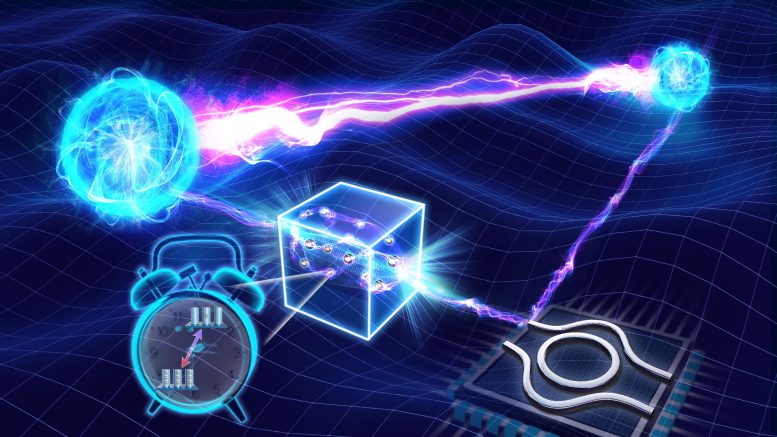
Physicists have achieved a major breakthrough in quantum technology by significantly extending quantum storage times at telecom wavelengths. This advancement is critical for developing practical quantum networks and integrating them into existing fiber optic infrastructures.
Quantum technologies are currently maturing at a breathtaking pace. These technologies exploit principles of quantum mechanics in suitably engineered systems, with bright prospects such as boosting computational efficiencies or communication security well beyond what is possible with devices based on today’s ‘classical’ technologies.
As with classical devices, however, to realize their full potential, quantum devices will need to be networked. In principle, this can be done using the fiber optic networks employed for classical telecommunications. But practical implementation requires that the information encoded in quantum systems can be reliably stored at the frequencies used in telecom networks — a capability that has not yet been fully demonstrated.
Writing in Nature Communications, the group of Prof. Xiao-Song Ma at Nanjing University reports record-long quantum storage at telecom wavelengths on a platform that can be deployed in extended networks, paving the way for practical large-scale quantum networks.
Optical Fibers and Quantum Challenges
The physical fabric of the Internet is woven from optical fibers. The glass fibers that make up these vast networks are famously pure. A common example is that you could see clearly through a kilometre-thick window made of such glass. Nonetheless, some losses are unavoidable, and the optical signals that travel through telecommunications networks need to be ‘refreshed’ at regular intervals once distances exceed a few hundred kilometers. For classical signals, there exist well-established and routinely used techniques based on repeated signal amplification. For quantum states of light, however, these routinely used approaches are unfortunately not suitable.
Why is ‘quantum light’ different? A key ingredient that makes quantum technologies so powerful is quantum entanglement, a state in which two or more quanta of light (or, photons) share between them stronger correlations than is possible for classical light. In conventional optical signal regeneration, the optical signal is converted into an electrical signal, which is amplified before being converted back into light pulses. However, in such a process entangled photons would lose their all-important quantum correlations. The same problem occurs with other conventional methods.
A solution is to use so-called quantum repeaters. In a nutshell, quantum repeaters store the fragile entangled state and transform it into another quantum state that shares entanglement with the next node down the line. In other words, instead of amplifying the signal, the nodes are ‘stitched together’, exploiting their unique quantum properties. At the heart of such quantum-repeater networks are quantum memories in which quantum states of light can be stored. Realizing these memories with a sufficiently long storage time is an outstanding challenge, especially for photons at telecom wavelengths (that is, around 1.5 µm).
Breakthrough in Quantum Storage
Hence the excitement as Ming-Hao Jiang, Wenyi Xue and colleagues in the group of Xiao-Song Ma now report storage and retrieval of the entangled state of two telecom photons with a storage time of close to two microseconds. This is almost 400 times longer than what had been demonstrated before in this field and therefore is a decisive step towards practical devices.
The memories developed by Jiang, Xue et al. are based on yttrium orthosilicate (Y2SiO5) crystals doped with ions of the rare-earth element erbium. These ions have optical properties that are almost perfect for use in existing fiber networks, matching the wavelength of around 1.5 μm. The suitability of erbium ions for quantum storage has been known for some years, and the fact that they are embedded in a crystal makes them particularly attractive with a view to large-scale applications. However, practical implementations of erbium-ion-based quantum memories proved relatively inefficient so far, hindering further progress towards quantum repeaters.
Ma’s group has now made significant advances in perfecting the techniques and has shown that even after storing the photon for 1936 nanoseconds, the entanglement of the photon pair is preserved. This means that the quantum state can be manipulated during this time, as is required in a quantum repeater. In addition, the researchers combined their quantum memory with a novel source of entangled photons on an integrated chip.
This demonstrated ability to both generate high-quality entangled photons at telecom frequencies and store the entangled state, all on a solid-state platform suitable for low-cost mass production, is exciting as it establishes a promising building block that might be combined with existing large-scale fiber networks — thereby enabling a future quantum internet.
Reference: “Quantum storage of entangled photons at telecom wavelengths in a crystal” by Ming-Hao Jiang, Wenyi Xue, Qian He, Yu-Yang An, Xiaodong Zheng, Wen-Jie Xu, Yu-Bo Xie, Yanqing Lu, Shining Zhu and Xiao-Song Ma, 1 November 2023, Nature Communications.
DOI: 10.1038/s41467-023-42741-1
3 Comments
The physical essence of quantum is the spin of topological vortices, rather than a dead and alive cat. Spin generates gravity. Spin generates energy. Spin generates evolution. Spin generates time. If you are really interested in science, you can browse the comments of https://scitechdaily.com/microscope-spacecrafts-most-precise-test-of-key-component-of-the-theory-of-general-relativity/.
The physical essence of quantum is the spin of topological vortices. A correct understanding of the physical essence of quantum helps us establish a correct and scientific worldview, and helps physics overcome the quagmire of pseudoscience. Pseudo academic journals are a cancer in the development of sciences and humanities. They will not bring civilization and progress to humaniny society, but will only promote hypocrisy, dirtiness, and ugliness of the pseudo academic community.
The Physical Review Letters (PRL) are the biggest cancer that spread pseudoscience. The CP violation it spreads has been hindering the progress and development of physics. If you are interested, you can browse the comments of https://scitechdaily.com/microscope-spacecrafts-most-precise-test-of-key-component-of-the-theory-of-general-relativity/.
Vector direction and vector distance using z-cSquare+extra plus other sides then square root and adding another element possi Ina solarwind inenable ic